-
生物活性
UMI-77, a selective binding inhibitor ofMcl-1, induces apoptosis in pancreatic cancer cells by blocking the interactionof Mcl-1 with Bax and Bak. UMI-77 is a novel selective Mcl-1 SMI inhibitor. Inhibits cell growth and induces apoptosis in PC cells in a time and dose-dependent manner, accompanied by cytochrome c release and caspase-3 activation. UMI-77 binds to the BH3 binding groove of Mcl-1 with Ki of 490 nM, showing selectivity over other members of anti-apoptotic Bcl-2 members.
Cytotoxic effect of UMI-77

Growth inhibition of UMI-77
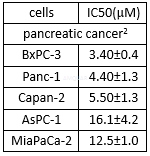
Bindingaffinity of UMI-77 in competitive FP-based and SPR-based binding assay[2]
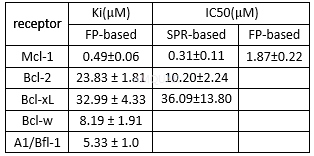
-
体外研究
-
体内研究
5% DMSO+30% PEG 300+dd H2O
-
激酶实验
Determine Kd values of fluorescent probes toproteins[2]
Fluorescein tagged BID BH3 (Bcl-2 Homology3) peptide was used as a fluorescent probe in the FP-based binding assays. Onefluorescein tagged BID peptide named as Flu-BID, labeled with fluorescein onthe N-terminus of the BH3 peptide (79-99), while the second tracer was named asFAM-BID, where the BH3 peptide (80-99) is labeled with 5-FAM. Their Kd valueswere determined to all members of the Bcl-2 family proteins with a fixedconcentration of the tracer (2nM of Flu-BID and FAM-BID) and differentconcentrations of the tested proteins, in a final volume of 125μl in the assaybuffer (100mM potassium phosphate, pH 7.5, 100μg/ml bovine γ-globulin, 0.02%sodium azide, with 0.01% Triton X-100 and 4% DMSO). Plates were mixed andincubated at room temperature for 2 hours and the polarization values inmillipolarization units (mP) were measured at an excitation wavelength of 485nm and an emission wavelength of 530 nm. Equilibrium dissociation constants(Kd) were calculated by fitting the sigmoidal dose-dependent FP increases as afunction of protein concentrations using Graphpad Prism 5.0 software. Basedupon analysis of the dynamic ranges for the signals and their Kd values,Flu-BID was selected as the tracer in the Mcl-1 and Bcl-2 competitive bindingassays, while FAM-BID was selected as the tracer for the rest of the proteins,A1/Bfl-1, Bcl-w and Bcl-xL. The Kd value of Flu-BID to Mcl-1 was 34 ± 3.5 nM,and to Bcl-2 was 20 ± 0.86 nM and the Kd values of FAM-BID to A1/Bfl-1 was 0.83± 0.06 nM, to Bcl-w was 5.5 ± 1.6 nM, and to Bcl-xL was 10 ± 4.0 nMrespectively, in our saturation experiments.
DetermineIC50 values of Mcl-1 inhibitors
Based on the Kd values, the concentrationsof the proteins used in the competitive binding experiments were 90nM forMcl-1, 40nM for Bcl-w, 50nM for Bcl-xL, 60nM for Bcl-2, and 4nM for A1/Bfl-1.The fluorescent probes, Flu-BID and FAM-BID were fixed at 2nM for all assaysexcept for A1/Bfl-1 where FAMBID was used at 1nM. 5μL of the tested compound inDMSO and 120μL of protein/probe complex in the assay buffer (100mM potassiumphosphate, pH 7.5; 100μg/ml bovine gamma globulin; 0.02% sodium azide) wereadded to assay plates, incubated at room temperature for 3 h and thepolarization values (mP) were measured at an excitation wavelength at 485 nmand an emission wavelength at 530 nm using the plate reader Synergy H1 Hybrid, BioTek.IC50 values were determined by nonlinear regression fitting of the competitioncurves.
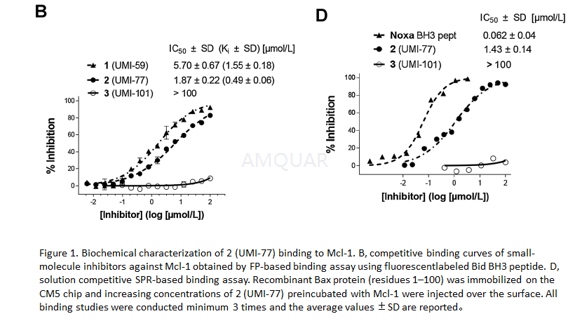
-
细胞实验
Cell Culture, Drug Solutions, and RNAi[3]
Cells were grown in DMEM (Panc-1,MiaPaCa-2), RPMI1640 (BxPC-3) or HybriCare (ATCC) with 30ng/ml epidermal growthfactor (CCL-241, normal human small intestine epithelial cells) mediasupplemented with and 10% fetal bovine serum, 2mmol/L l-glutamine andpenicillin/ streptomycin. Experiments were conducted on exponentially growingcells. Cells were tested for Mycoplasma once every 3 months. UMI77 wasdissolved in DMSO and stored at −20°C. Cells were transfected with siRNA usingOligofectamine or X-treme gene transfection reagents.
Irradiation
Irradiations were performed using a PhilipsRT250 at a dose rate of ∼2Gy/min. Dosimetrywas carried out using an ionization chamber connected to an electrometer system.
ClonogenicSurvival Assay
Clonogenic assays were carried out usingstandard techniques. For siRNA experiments, cells were transfected at 30-50%confluency (as described above) and at 48 hours post-transfection plated atclonal densities and then irradiated. For drug experiments, cells were platedat clonal densities and then treated with UMI77 and radiation. Cells were grownat 37°C for 7–12 days for colony formation. The cytotoxicity of UMI77 or Mcl-1 siRNAin the absence of radiation treatment was calculated as the ratio of survivingtreated cells relative to surviving vehicle or nonspecific siRNA -treatedcells, respectively. Radiation survival data from treated cells were correctedfor plating efficiency by normalizing to un-irradiated control cells. Cellsurvival curves were fitted using the linear-quadratic equation, and the meaninactivation dose was calculated and used to determine the radiationenhancement ratio. Radiosensitization is indicated by a radiation enhancementratio of significantly greater than 1.
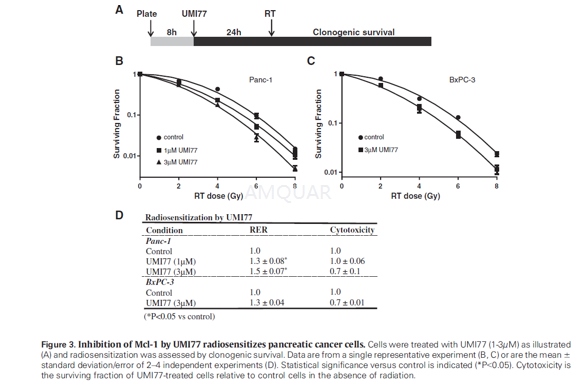
-
动物实验
Animal preclinical efficacy trail design[2]
For BxPC-3 subcutaneous model, 10 x 106 cells were subcutaneously injected into the flanks of 4- to 5-week-old femalesevere combined immunodeficient mice. Palpable tumors started to appear in 3 to5 weeks. Tumors were measured twice weekly. To prevent any pain or discomfort,mice were euthanized and their tumors removed once they reached ~1,800 mg burden.Tumors were then dissected into 50mg pieces and re-transplanted into naiveICR-SCID for serial propagation. Animals were treated with either vehicle orUMI-77 given i.v. (60mg/kg) on day 3 after BxPC-3 transplantation for 2 weeks(5 days a week). Tumor weight was recorded throughout the treatment period. Atthe end of the treatment period, animals were euthanized and their tumorsharvested for protein isolation and Western blot analysis for apoptoticmarkers.
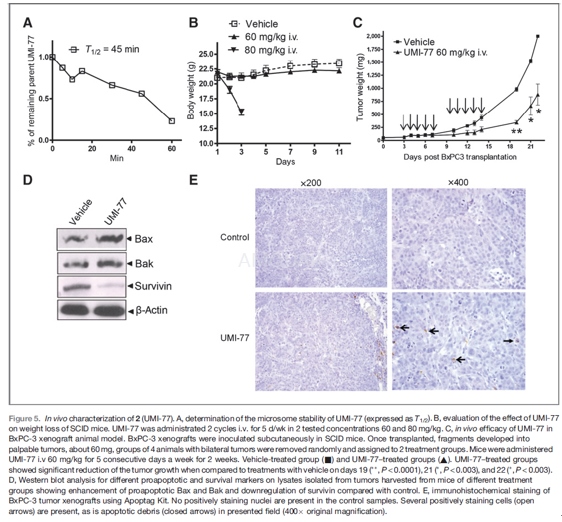
-
不同实验动物依据体表面积的等效剂量转换表(数据来源于FDA指南)
|  动物 A (mg/kg) = 动物 B (mg/kg)×动物 B的Km系数/动物 A的Km系数 |
|
例如,已知某工具药用于小鼠的剂量为88 mg/kg , 则用于大鼠的剂量换算方法:将88 mg/kg 乘以小鼠的Km系数(3),再除以大鼠的Km系数(6),得到该药物用于大鼠的等效剂量44 mg/kg。
-
参考文献
[1] Liu JW, Zhu ZC, Li K, Wang HT, Xiong ZQ, Zheng J. UMI-77 primes glioma cells for TRAIL-induced apoptosis by unsequestering Bim and Bak from Mcl-1. Mol Cell Biochem. 2017.
[2] Abulwerdi F, Liao C, Liu M, et al. A novel small-molecule inhibitor of mcl-1 blocks pancreatic cancer growth in vitro and in vivo. Mol Cancer Ther. 2014;13(3):565-575.
[3] Wei D, Zhang Q, Schreiber JS, et al. Targeting mcl-1 for radiosensitization of pancreatic cancers. Transl Oncol. 2015;8(1):47-54.
分子式
C18H14BrNO5S2 |
分子量
468.34 |
CAS号
518303-20-3 |
储存方式
﹣20 ℃冷藏长期储存。冰袋运输 |
溶剂(常温)
|
DMSO
>50 mg/mL |
Water
<1 mg/mL |
Ethanol
>50 mg/mL |
体内溶解度
10 mg/mL
-
Clinical Trial Information ( data from http://clinicaltrials.gov )
注:以上所有数据均来自公开文献,并不保证对所有实验均有效,数据仅供参考。
-
相关化合物库
-
使用AMQUAR产品发表文献后请联系我们























